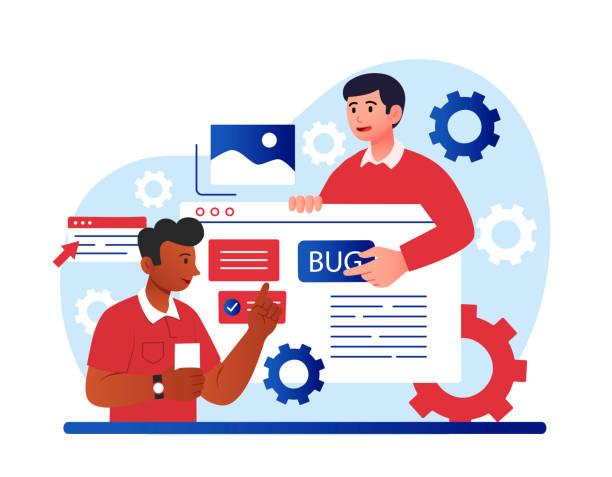The Unparalleled Importance of Secure Website Design in the Digital Age

In today’s world, where digital boundaries are rapidly expanding, the importance of #secure_website_design has become more prominent than ever. With the increasing proliferation of cyber threats and sophisticated attacks, businesses and users are exposed to serious risks.
Every website, from a simple personal blog to a large e-commerce platform, can be a target for attackers.
Consequently, #data_protection and user privacy have become a necessity.
Failure to address this issue can lead to the loss of sensitive information, damaged reputation, heavy fines, and even the complete loss of a business.
For example, a leak of banking information or users’ personal details can be catastrophic and severely undermine public trust.
Therefore, every step towards secure website development must be taken with care and prior planning.
Secure website design is not just an option, but a requirement to ensure stability and security in today’s challenging digital environment.
This article, in an explanatory and educational manner, explores various aspects of web security and provides practical solutions to achieve it.
Are you tired of your company’s website not meeting your expectations? Design a professional website with Rasaweb that truly reflects your business.
✅ Increase new customer acquisition and sales leads
✅ Enhance your brand’s credibility and trust with your audience
⚡ Get a free website design consultation!
Identifying Common Web Vulnerabilities: Challenges of Secure Website Design

To achieve secure website design, a deep understanding of common web vulnerabilities is essential.
Attackers are always looking for weaknesses in systems to exploit them.
One of the most common vulnerabilities is SQL Injection, which allows an attacker to inject malicious SQL code into programming inputs and gain access to the database.
This can lead to data theft, modification, or deletion.
Another vulnerability is Cross-Site Scripting (XSS), where an attacker injects malicious script code into web pages, which then executes in other users’ browsers, potentially leading to cookie theft, phishing, or content alteration.
Broken Authentication, such as weak session management or insecure passwords, opens the door for intruders.
Also, Insecure Direct Object References occur when developers directly access internal system objects without proper authorization checks, allowing an attacker to access files or data they should not.
Security Misconfiguration, including insecure default settings, failure to remove unnecessary features or open services, is also very common.
Understanding these vulnerabilities is a specialized and educational step and the first step towards implementing a secure and reliable web foundation.
Detailed knowledge of these security flaws helps programmers to take necessary measures to prevent them in the early stages of development.
Principles of Secure Coding and Cyberattack Prevention in Secure Website Design

Secure coding is the backbone of any secure website design.
To prevent many attacks, developers must follow specific principles throughout the development process.
Input Validation is of critical importance; any data received from the user must be checked for format, type, and content before processing.
This prevents the injection of malicious code or data.
Using Parameterized Queries or ORMs (Object-Relational Mappers) for database interaction is the main solution for combating SQL Injection, as it separates user input from SQL code.
Output Encoding is also essential for preventing XSS; any data sent to the user’s browser must be properly encoded so it is not interpreted as executable code.
Furthermore, strong encryption for user passwords (such as using one-way hashing functions with salt) and secure session management are key principles.
Using web development frameworks that have security at their core (such as Django, Ruby on Rails, Laravel) can automatically mitigate many common vulnerabilities.
It must always be ensured that all libraries and dependencies used are up-to-date to prevent known security holes in them.
These guiding and specialized approaches not only create a more secure website but also help reduce the costs associated with fixing vulnerabilities in the future.
Secure website design is an ongoing process, not a one-time action, that begins with secure coding.
| Vulnerability | Description | Prevention Methods in Secure Website Design |
|---|---|---|
| SQL Injection | Injecting malicious SQL code to access or manipulate the database. | Using Prepared Statements or ORM, precise input validation. |
| Cross-Site Scripting (XSS) | Injecting malicious scripts into web pages that execute in the user’s browser. | Output Encoding, using Content Security Policy (CSP). |
| Broken Authentication | Weak authentication and session management mechanisms. | Strong passwords, Multi-Factor Authentication (MFA), secure session management. |
| Insecure Direct Object References | Direct and uncontrolled access to internal system objects. | Implementing proper role-based access control based on user role and permissions. |
| Security Misconfiguration | Incorrect security configurations in the server, database, or framework. | Reviewing and hardening configurations, removing unnecessary services, regular updates. |
The Role of SSL/TLS Certificates in Securing Web Communications

One of the most important elements in secure website design is the implementation of SSL/TLS certificates.
SSL (Secure Sockets Layer) and its successor TLS (Transport Layer Security) are protocols that encrypt communications between the user’s browser and the website server.
This encryption ensures that transmitted data such as personal information, passwords, and credit card details remain safe from eavesdropping and tampering by third parties.
Without SSL/TLS, information is transmitted in plain text, and anyone along the transmission path can access it.
When a website uses HTTPS (HTTP Secure), it means it uses SSL/TLS to encrypt its traffic.
This not only enhances data security but also builds user trust, as browsers show websites without HTTPS as “not secure”.
Furthermore, Google and other search engines prefer HTTPS-enabled websites in their search rankings, which helps improve SEO.
There are different types of SSL certificates, including DV (Domain Validation) for blogs and personal sites, OV (Organization Validation) for businesses, and EV (Extended Validation) which provides the highest level of assurance and displays a green bar with the organization’s name in the address bar.
Choosing the appropriate type of certificate for securing your website is a specialized and explanatory action and an integral part of a comprehensive secure website design strategy.
Don’t have a corporate website yet and missing out on online opportunities? With professional corporate website design by Rasaweb,
✅ Double your business credibility
✅ Attract new customers
⚡ Get a free consultation for your corporate website!
Robust Authentication and Authorization Mechanisms in Secure Website Design

Authentication and Authorization are two fundamental pillars of secure website design.
Authentication is the process of verifying a user’s identity, while authorization determines what operations a user can perform and what resources they can access after authentication.
Weak authentication systems are one of the most common security vulnerabilities.
To strengthen authentication, using strong and unique passwords is crucial; users should be encouraged to use long, complex, and unguessable passwords and change them regularly.
Multi-Factor Authentication (MFA) adds an extra layer of security, requiring the user to provide another factor (such as a code sent to their phone, a fingerprint, or a hardware token) in addition to their password.
This method maintains account security even if the password is compromised.
Secure session management is also very important; session tokens must be random and long, transmitted over HTTPS, and expire after a specified period.
In the realm of authorization, implementing Role-Based Access Control (RBAC) is a recommended specialized and educational approach.
In RBAC, instead of assigning permissions individually to each user, permissions are assigned to roles (e.g., administrator, editor, regular user), and then users are assigned to one or more roles.
This simplifies permission management and reduces security errors.
A secure website must ensure that each user only has access to the resources they need to perform their tasks, and no more.
Security Audits and Penetration Testing: Tools for Continuous Improvement in Secure Website Design

Secure website design is not a static process, but requires continuous review and improvement.
Even with the best coding practices and configurations, new vulnerabilities may emerge over time or with the introduction of new features.
This is where regular security audits and Penetration Testing become crucial.
Security audits involve reviewing code, server settings, and network configurations to identify weaknesses.
These reviews can be performed automatically using Vulnerability Scanners, which quickly identify known weaknesses.
But penetration testing goes a step further.
In penetration testing, security professionals (also known as ethical hackers) attempt to breach the system by simulating real-world attacks to discover unknown or logical vulnerabilities.
This can include attempts to bypass authentication mechanisms, exploit misconfigurations, or even try social engineering on employees.
The results of penetration testing provide a comprehensive report of discovered vulnerabilities and recommendations for their remediation.
Performing these tests periodically, especially after major changes to the code or infrastructure, is vital for maintaining a secure website.
This analytical and guiding approach allows organizations to proactively address their weaknesses before they are discovered by real attackers.
Ultimately, investing in penetration testing and security audits is an investment in the sustainability and credibility of a secure site.
Data Protection and User Privacy: The Backbone of Secure Website Design

In the information age, data protection and user privacy are not only an ethical responsibility but also a legal and fundamental requirement in secure website design.
With increasing concerns about how personal information is collected, stored, and processed, stricter laws such as the General Data Protection Regulation (GDPR) in Europe and similar laws in other regions of the world have been enacted.
Failure to comply with these laws can lead to heavy fines and serious damage to a business’s reputation.
To ensure comprehensive data protection, several principles must be observed.
Data encryption at rest and in transit is a fundamental layer of protection.
Sensitive data stored in the database (data at rest) must be encrypted so that it is unusable by an attacker even if breached.
On the other hand, as previously mentioned, data in transit must be encrypted through protocols like HTTPS.
The principle of Data Minimization states that only data necessary for a specific and legitimate purpose should be collected.
Collecting excessive or unnecessary data should be avoided.
Obtaining informed consent from users for the collection and use of their data is also vital.
Users must be transparently informed about how their information is used and have the right to withdraw their consent.
Furthermore, Privacy by Design means that privacy considerations must be integrated from the very early stages of website design and development, and not as an additional feature after completion.
This specialized and informative approach ensures that a secure site is not only technically secure but also respects users’ privacy rights.
| Principle | Description | Importance in Secure Website Design |
|---|---|---|
| Data Encryption | Protecting data at rest (in the database) and in transit (between browser and server). | Preventing unauthorized access to sensitive information even in case of a breach. |
| Data Minimization | Collecting and retaining only information essential for a specific purpose. | Reducing the risk of data leaks and legal liability in case of a security breach. |
| Informed Consent | Obtaining clear permission from users for collecting and processing their information. | Respecting user privacy rights and relevant regulations. |
| Privacy by Design | Integrating privacy considerations from the initial stages of system design. | Building a system that ensures privacy from the outset, rather than adding it later. |
| Right to Access and Rectify Information | Providing users with the ability to view, modify, or delete their personal information. | Increasing transparency and user control over their data, in accordance with regulations. |
Incident Response and Disaster Recovery Plan: Ensuring the Stability of a Secure Site

Even with the best approach to secure website design, no system is 100% impenetrable.
Cyberattacks are becoming more sophisticated, and a security breach may occur one day.
In such circumstances, having an Incident Response Plan and a Disaster Recovery Plan is crucial.
These plans ensure that in the event of an attack or system failure, the organization can quickly react, minimize damage, and resume normal operations.
The Incident Response Plan includes specific steps: 1.
Identification (detecting a security incident), 2.
Containment (preventing the spread of damage), 3.
Eradication (complete removal of the intrusion agent), 4.
Recovery (restoring systems to a secure operational state), and 5.
Lessons Learned (analyzing the incident to prevent its recurrence in the future).
Having an incident response team, appropriate tools for log management, and automated alerting systems are essential elements of this plan.
The Disaster Recovery Plan focuses on restoring business operations after a major event, such as server failure, data loss, or ransomware attacks.
This plan includes regular backups of all critical data and configurations, storing these backups in secure and off-site locations, and continuous testing of the recovery process.
The main goal is to minimize Downtime and Data Loss.
These guiding and specialized approaches demonstrate that building a secure site is not limited to preventing attacks, but also includes preparing for worst-case scenarios and the ability to recover quickly.
Don’t have a corporate website yet and missing out on online opportunities? With professional corporate website design by Rasaweb,
✅ Double your business credibility
✅ Attract new customers
⚡ Get a free consultation for your corporate website!
User Training: The Missing Link in the Secure Website Design Chain

Often in the discussion of secure website design, much focus is placed on technical and infrastructural aspects, but a critical element that is sometimes overlooked is the human factor.
Users, whether organizational staff or website customers, can be the strongest defense or the most vulnerable point of a system.
Many successful cyberattacks, including phishing, social engineering, and malware attacks, exploit human error or lack of awareness.
To complete the website security puzzle, user training and awareness are essential.
These trainings should include: 1.
Identifying phishing emails and suspicious messages, 2.
The importance of using strong and unique passwords and password management tools, 3.
The risk of clicking on unknown links or downloading files from untrusted sources, 4.
Maintaining online privacy and cautious sharing of personal information.
Thought-provoking content here: Are your users sufficiently aware of security threats? Do they know that a single wrong click can jeopardize the entire organization’s security? Training should not be dry and boring; phishing attack simulations, competitions, and interactive tools can be used to increase engagement.
The educational nature of this part of secure website design ensures that all defensive aspects, from coding to user behavior, are covered.
A secure site requires aware and responsible users.
The Future of Web Security and New Approaches in Secure Website Design

The world of cybersecurity is constantly evolving, and with the emergence of new technologies, threats also evolve.
Therefore, secure website design is not a static process, but requires continuous adaptation to the changing security landscape.
The future of web security is moving towards more proactive, automated, and intelligent approaches.
One of the key concepts in this area is DevSecOps; a philosophy that integrates security from the very early stages of software development (Design and Development) into the development lifecycle and considers it the responsibility of all team members, not just the security team.
The use of Artificial Intelligence (AI) and Machine Learning (ML) in web security is also expanding.
These technologies can be used to detect suspicious patterns, identify anomalies, and predict future attacks, allowing a website security system to react faster and more intelligently.
Also, with the expansion of the Internet of Things (IoT) and the increasing number of connected devices, IoT security becomes a new challenge that must be included in comprehensive website security strategies.
Concepts such as Zero Trust Architecture, which is based on the principle of “never trust, always verify,” are also gaining popularity.
This approach assumes that no user, whether inside or outside the network, is trustworthy, and all requests must be fully authenticated and authorized.
This analytical and engaging view of the future shows that secure website design is constantly evolving and requires up-to-date knowledge and creativity to counter new and unknown threats.
Frequently Asked Questions
| Question | Answer |
|---|---|
| 1. What does secure website design mean? | Secure website design means creating a website that is resilient against cyberattacks and protects user and server information. |
| 2. Why is security important in website design? | To prevent data breaches, maintain user privacy, retain user trust, and avoid financial and reputational damage. |
| 3. What are the most common web vulnerabilities? | SQL Injection, Cross-Site Scripting (XSS), Cross-Site Request Forgery (CSRF), Broken Authentication, and Security Misconfiguration. |
| 4. How can SQL Injection be prevented? | By using Prepared Statements / Parameterized Queries, ORMs, and Input Validation. |
| 5. What is the role of HTTPS and SSL/TLS in website security? | HTTPS uses the SSL/TLS protocol to encrypt communication between the user’s browser and the server, preventing data interception and manipulation. |
| 6. What measures should be taken to prevent XSS attacks? | Input validation, Output Encoding to prevent malicious code execution, and using Content Security Policy (CSP). |
| 7. What does a strong password policy include? | Enforcing the use of long passwords, a combination of uppercase and lowercase letters, numbers, and special characters, and preventing reuse. |
| 8. How does Two-Factor Authentication (2FA) help with security? | Even if a user’s password is compromised, the attacker cannot access the account without the second authentication factor (e.g., an SMS code or an authenticator app). |
| 9. What is a Web Application Firewall (WAF) and what is its use? | A WAF is a firewall that monitors and filters HTTP traffic between a web application and the internet to prevent common web attacks such as SQL Injection and XSS. |
| 10. Why is regular updating of software and libraries important? | Updates often include security patches to fix discovered vulnerabilities. Failure to update can expose the site to new attacks. |
And other services of Rasaweb Advertising Agency in the field of advertising
Smart Marketing Automation: A creative platform to improve campaign management with marketing automation.
Smart Digital Branding: A professional solution for customer behavior analysis focusing on SEO-driven content strategy.
Smart SEO: A fast and efficient solution for online growth focusing on precise audience targeting.
Smart Social Media: Transform SEO ranking improvement with attractive UI design.
Smart Social Media: Designed for businesses seeking online growth through an SEO-driven content strategy.
And over hundreds of other services in internet advertising, advertising consultation, and organizational solutions
Internet Advertising | Advertising Strategy | Sponsored Content
Resources
Website Security Guide
Security Tips for WordPress
Best Practices for Website Security
How to Secure Your Website
? Are you ready to transform your business in the digital world? Rasaweb Afarin Digital Marketing Agency, by offering innovative solutions including responsive website design and professional optimization, paves your path to online success. To get seen, grow, and increase customers, contact us today.
📍 Tehran, Mirdamad Street, next to Bank Markazi, Southern Kazeroon Alley, Ramin Alley, No. 6



